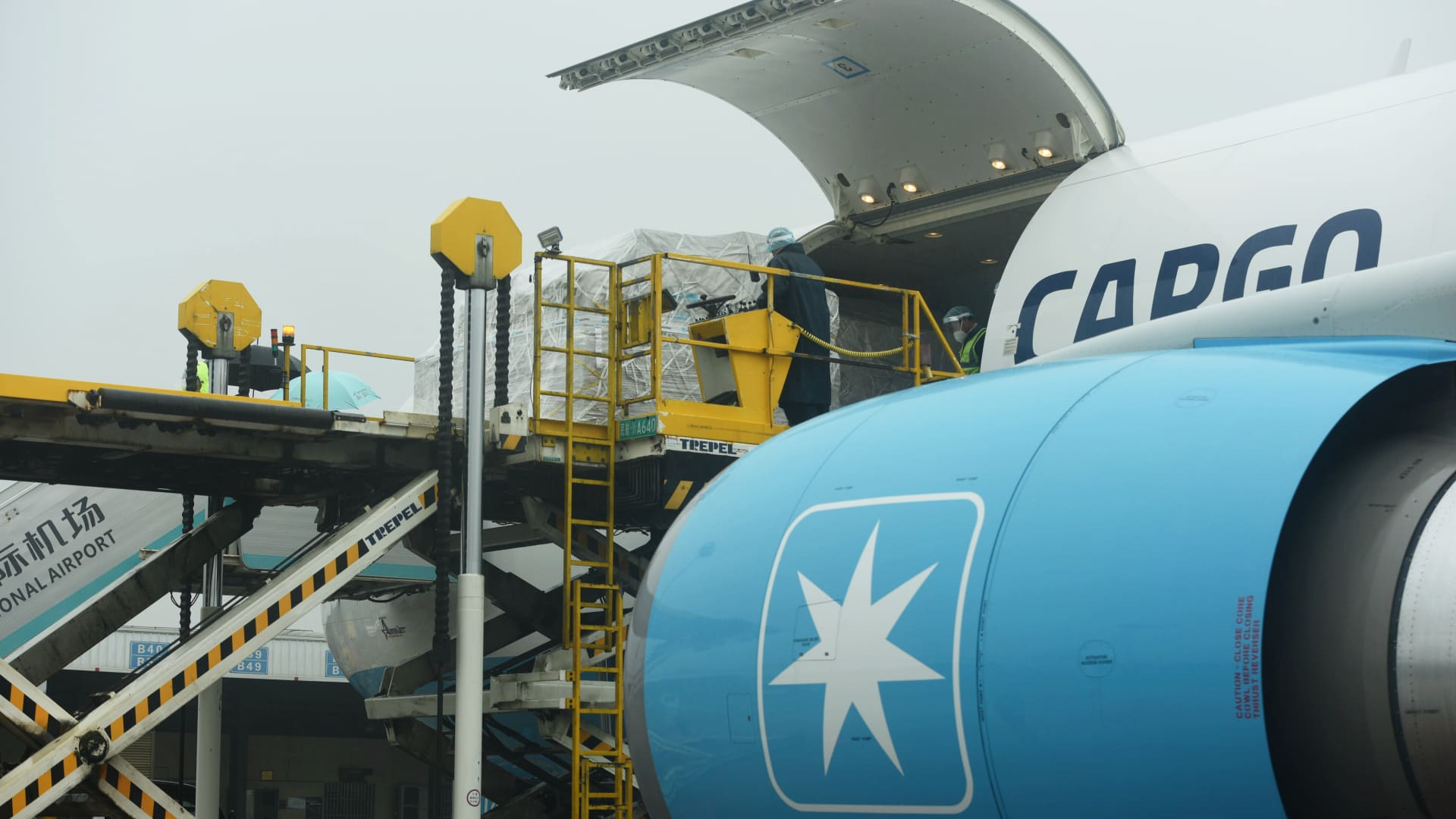HANGZHOU, CHINA – APRIL 6, 2023 – A Cargo plane of Maersk AIR Cargo is seen at Hangzhou Xiaoshan International Airport in Hangzhou, Zhejiang province, China, April 6, 2023. On November 4, 2023, the international shipping industry giant Maersk’s revenue in the third quarter of 2023 was 12.13 billion US dollars, down 46.73% year-on-year; Net profit was $554 million, down 93.78 percent from a year earlier. Maersk also said it would cut at least 10,000 jobs to reduce costs. (Photo by Costfoto/NurPhoto via Getty Images)
Nurphoto | Nurphoto | Getty Images
The lengthy diversions for ocean cargo vessels as a result of the Houthi rebel attacks in the Red Sea have caused air freight volumes to soar, and the cost of shipping cargo by plane will see a significant increase if the crisis does not abate, with anxiety rising among companies.
The current spike in use of air freight is primarily in cargo volumes bound for Europe, as more companies avoid the longer Red Sea diversions around Africa’s Cape of Good Hope, according to Xeneta, a leading ocean and air freight rate benchmarking platforms.
Air freight tends to be “quieter” in the last week of December and the first week of January, according to Niall van de Wouw, chief air freight officer for Xeneta. But the recent data and anecdotal information from clients makes this period different. “A couple of weeks ago, I started speaking with companies and I found retailers were starting to consider air freight as a way to get their products directly to their customers,” van de Wouw said. The Red Sea crisis has increased fears of a renewed bout of supply chain inflation, but so far, “what’s even more compelling is the spike in volumes. To see increases of this magnitude, with higher volumes than at any point in 2023, is significant,” he said.
Flights are already on average 93% full from a cargo perspective, and it is likely air freight rates will increase much more than 10% if the current increase in demand continues.
“If the Rea Sea crisis continues, you’ll have more and more companies getting nervous,” van de Wouw said.
Comparisons are being made to the pandemic supply chain shocks for both ocean and port bottlenecks and rate spikes throughout the shipping industry. Van de Wouw said other key differences for air freight between the pandemic and now are the return of passengers and a lower overall level of consumer demand. “It was a capacity issue,” said van de Wouw of the pandemic. “Here you have a demand spike not because consumers are spending more but the need of companies to move products. This is all a result of companies trying to mitigate the ocean transit delays.”
Xeneta data shows that air cargo volumes on the major apparel route from Vietnam to Europe spiked 62% in the week ending January 14 — 6% higher than 2023’s peak week in October. The same week 12 months ago showed a 16% increase.
“Rates have not yet hit anywhere near the levels we saw during Covid-19, but the sudden nature of the Red Sea crisis has seen a more rapid increase in rates which is arguably creating even more disruption than during the early months of the pandemic,” said Xeneta data analyst Emily Stausbøll.
Around 28% of the world’s container trade traverses through the Suez Canal/Red Sea. According to Bank of America, almost 30% of the goods in these containers are furniture, household goods and clothing and apparel. General Electrical appliances are also top items moved along this route.
Bank of America’s Lorraine Hutchison explained in a recent note that brands with significant European exposure due to the longer transits from Asia to Europe include Phillips-Van Heusen Corporation, Birkenstock, Capri Holdings Limited, Nike, Ralph Lauren, VF Corp, and Levi Strauss & Co.
Phillips-Van Heusen brands include Tommy Hilfiger, Calvin Klein, Warner’s, Olga and True & Co. Capri Holdings Limited brands include Versace, Jimmy Choo, and Michael Kors. VF Corp activity-based lifestyle and workwear brands, include Vans, The North Face, Timberland, and Dickies.
Sailing around the Cape of Good Hope to avoid the Red Sea adds one to two weeks to a one-way shipping journey relative to the Red Sea and Suez Canal. Europe’s route is longer than the U.S. in this diversion, which is why air freight usage is up.
Logistics managers favor the Suez Canal because it is the fastest route from Southeast Asia to Europe and the U.S. East Coast.
“Asia-Europe sailing days could potentially increase by 30% and the majority of traffic through the Suez Canal is bound for Europe,” Hutchison wrote.
Specialty retailers rely most on ocean transit to move products from Asia to the U.S. Department stores are less affected since the products purchased are already in the U.S. “Off price has some ocean exposure (mostly home) but most goods are purchased domestically,” wrote Hutchison.
Auto companies including Suzuki Motors, Tesla, and Volvo have announced manufacturing impacts, with suspensions in Europe as a result of components being delayed.
“We continue to monitor the situation and we’re using alternate routes and shipping methods to minimize impact where we can,” Lars Weborg, a Ford spokesman, told CNBC.
Ikea has warned of delays of product, as well as British retailer Next and Crocs.
“We are definitely seeing the conversion to air freight for anything from fashion apparel to automotive parts,” said Brian Bourke, global chief commercial officer for SEKO Logistics. “It’s not quite Covid times where we were shipping hot tubs via air freight, but the additional delays, combined with the rush before Lunar New Year when factories shut down, has created a sense of urgency for many European importers that do not want to be left without stock or with factories idle for too long.”








